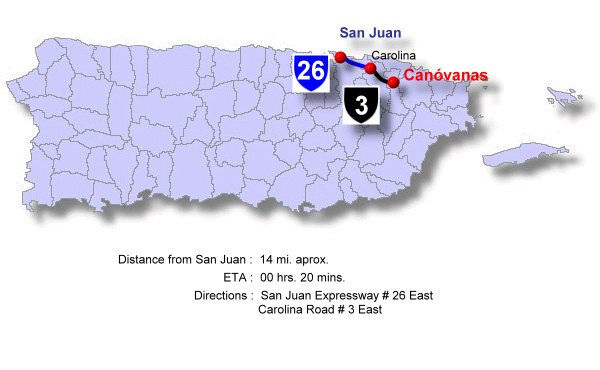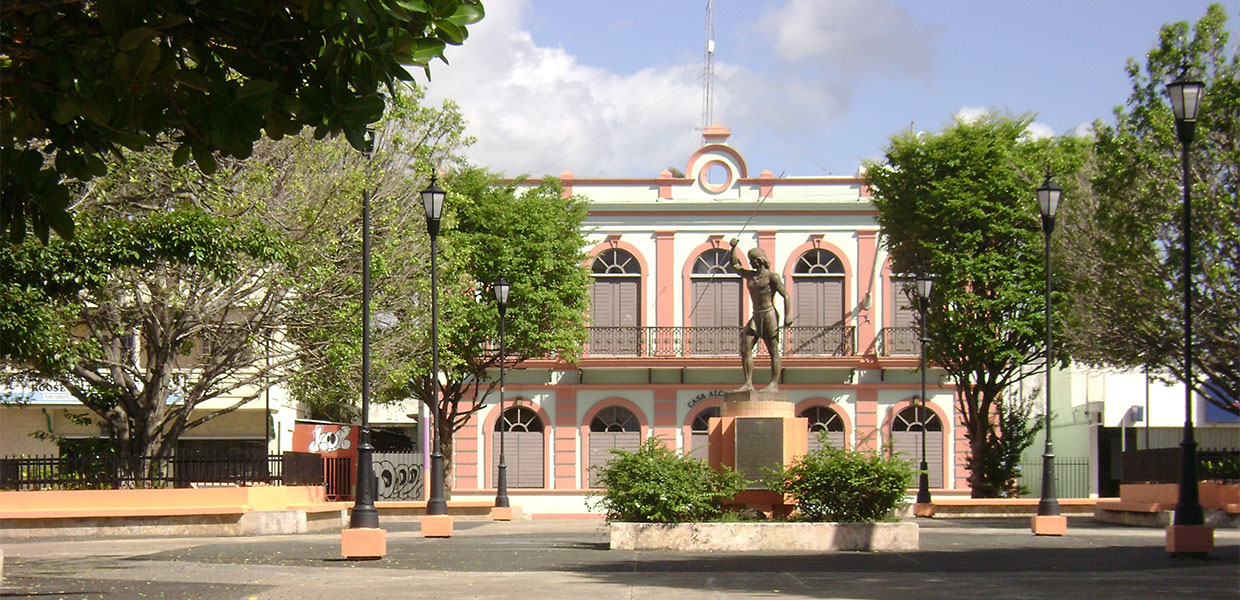
Canóvanas, Puerto Rico
Valiant Town
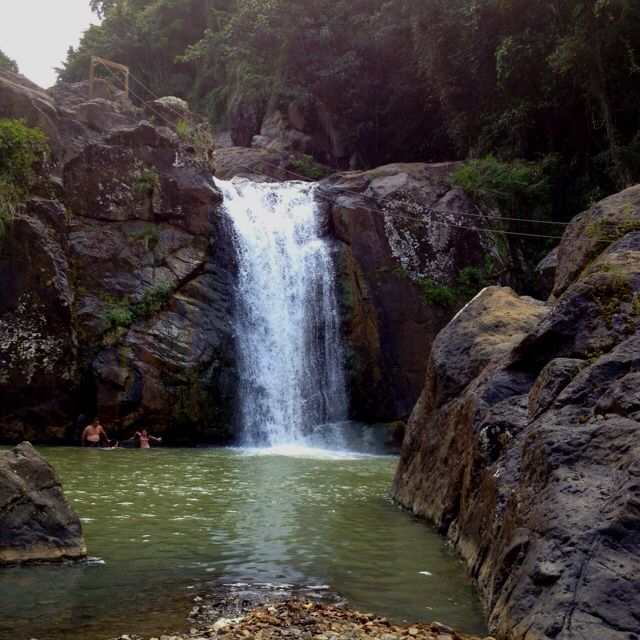
Canóvanas (kah-NO-vah-nahs) is known as the “brave town” an allusion to the feat of the cacique Yuira who lost her own life defending Spaniards against the tainos. It is also known as the “race town” where Camarero horse-racing track, Puerto Rico’s only racetrack, is located, and “the town of the Chupacabras”. The patron of the municipality is Our Lady of the Pillar.
Canóvanas is located on the northeast area of Puerto Rico and is bordered on the north by Loíza, on the south by Juncos and Las Piedras, on the east by Río Grande and Loíza, and on the west by Carolina and Gurabo. It is located on the northern coastal plain, and the northern and central areas of the municipality are largely flat.
Canóvanas is known for its achievements in sports, especially basketball and volleyball. One of the nicknames of the town, “the Indians town,” refers to the name of the basketball team, which won the island-wide championship in 1983 and 1984. The women’s volleyball team, “Las Indias,” has also has won several championships.
There are several factories in the municipality which produce shoes, clothing, electrical and electronic products, chemicals, and food. Agricultural production includes coffee, fruit, vegetables, dairy farming, and fowl. Canóvanas has grown steadily in terms of population and construction as a consequence of its economic development and proximity to the metropolitan area of San Juan.
Foundation:
Founded in 1910 by Luis Hernaíz Veronne, it wasn’t until 1970 that it officially became a municipality. The name Canóvanas is derived from the Taíno Chief, Canóbana, who ruled the margins of the Grande de Loíza river, then called Cairabón or Cayniabón. Miguel Diaz was given charge of Canóbana and apparently Canóbana did not participate in the uprising of the indigenous people. Canóvanas is known as the “Valiant Town” (Pueblo Valeroso) because the Cacique (Chieftain) Yuira was killed defending the Spaniards from the Taínos.
The history of this municipality is complex and interesting. Until 1969 it had been a district of the Party of the Loíza, located in the southern end and away from the sea, it did not undergo attacks from the Caribes and Taínos that took place in the northern region. While communication from the Capital with the rest of the island was by sea or through the coastal routes, Canóvanas had little importance. That situation changed later when other routes were opened.
In 1900 the relative isolation of Loíza was remarkable; the neighbors solicited the Legislature to approve the transfer of the municipal capital to Canóvanas. But at that time the opinion prevailed that there were too many municipalities in Puerto Rico. And indeed, in 1902, by means of the Law for the Consolidation of Certain Municipal Terms, the Legislative Assembly decided to incorporate Loíza and its districts (barrios) to Río Grande. Thus, by default, the district of Canóvanas became a dependency of Río Grande. Three years later another law countermanded the law of 1902 and Canóvanas returned to its origins.
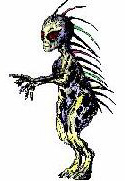
On November 30, 1909, the Municipal Council of Loíza approved a decree that transferred the municipal capital to Canóvanas. The reasons were that the old capital was no longer as isolated from the rest of its districts and its agricultural wealth could be included. Most important was the communication and the transportion which had been oriented towards Canóvanas by the construction of State Highway No. 3.
In this territory the City Council had already acquired twenty “cuerdas” (a cuerda being slightly smaller than an acre) of land properly parceled out, streets laid out, a meat market with a slaughter house annexed, and a fenced cemetery. With aid of the Insular Treasury, financing had been obtained to erect a two story City Hall. Being Canóvanas the capital now, the population of Loíza Village and the Northern region of the municipality continuously showed their opposition to depending on the old district.
The problem worsened to the extent that the Legislative Assembly decided to solve it. The Law of June 30, 1969, in its exhibition of reasons, recognized that both towns “was constituted of clearly different populations and possessed the requirements necessary to constitute themselves in separated municipalities.” Polls taken among the residents of both areas demonstrated that it was their desire to constitute themselves in independent municipalities. For such reasons the mentioned law created the municipality of Canóvanas, that would be integrated by districts segregated from Loíza.
A Special Commission was created to make recommendations for the defining of new borders, which in turn would be approved or rejected in special referendum by the resident voters. The same took effect August 16, 1970 and was approved. The 14th of September of that same year the Governor of Puerto Rico, Don Luis A. Ferré, dictated a proclamation putting into effect this definition and declared that according to the recommendations of the Special Commission “the municipality of Canóvanas will include and understand all the geographic districts or sectors not included in the demarcation for the municipality of Loíza”.
Location:
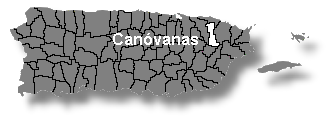 Located in the northeastern part of the island, it is bordered by: Loíza on the north, Juncos and Las Piedras on the south, Carolina and Gurabo on the west, and Río Grande and Loíza on the east.
Located in the northeastern part of the island, it is bordered by: Loíza on the north, Juncos and Las Piedras on the south, Carolina and Gurabo on the west, and Río Grande and Loíza on the east.
Area:
72.8 sq km / 28.0 sq mi
Population:
43,335 (census 2000)
Population Density:
595.2 per sq km / 1,547.6 per sq mi
People are known as:
Canovanenses
Canóvanas is also known as:
Pueblo Valeroso (Valiant Town)
Ciudad de los Indios (The Indians’ City)
La Ciudad de las Carreras (Racing City)
El Pueblo del Chupacabras (The ‘Chupacabras’ Town)
Wards: Canovanas, Puerto Rico

| Census 2000: Population by Wards – Canóvanas | Habitants |
| Canóvanas (ward) | 17,464 |
| Canóvanas Town | 4,361 |
| Cubuy | 1,674 |
| Hato Puerco | 7,361 |
| Lomas | 5,402 |
| Torrecillas Alta | 7,073 |
| Total | 43,335 |
Información: Source: Censo 2000
Patron:
Nuestra Señora del Pilar
Nuestra Señora del Pilar Parish
Apartado P
Canóvanas, P. R. 00629
Founded: 1903
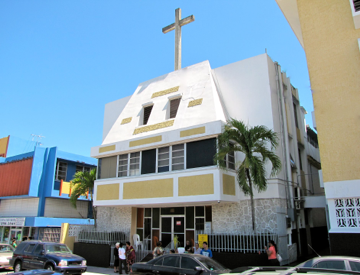
Topography:
Part of its central region and all of the north are plains. To the northeast of the town is the Cuchilla de Santa Inés, which is not higher than 100 meters.
Hydrography:
The Grande de Loíza river crosses its northwest region with its affluents: Canóvanas, Cubuy, Canovanillas, and Herrera rivers and several ravines.
Climate:
Average high temperature is 87.1º F and the average low is 67.8º F. Annual precipitation is 73.62 inches.
Economy:
The economy consists of, among others: the manufacture and distribution of footwear, electrical and electronic equipment, apparel and chemical agents. Agriculture is also included with: sugar cane, coffee, fruits, vegetables, cattle and poultry. The new El Commandante Racetrack is at the moment of great importance to the economy of the municipality.
Average Salary:
$292.01 weekly (1998)
Flag:
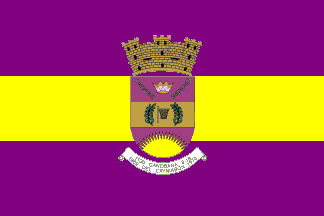 The flag derives its design, the yellow and purple colors and symbolism, from the municipal Coat of Arms. Designed in three horizontal stripes: the first violet, the second gold with the Coat of Arms of the municipality in the center, and the third violet.
The flag derives its design, the yellow and purple colors and symbolism, from the municipal Coat of Arms. Designed in three horizontal stripes: the first violet, the second gold with the Coat of Arms of the municipality in the center, and the third violet.
Coat Of Arms:
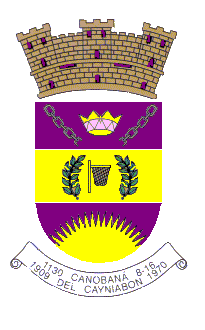 After several polls and confrontations of ideas and fervent suggestions to provide a Coat of Arms that distinguished the town for its acts and history, the Coat of Arms today contains the following symbolisms:
After several polls and confrontations of ideas and fervent suggestions to provide a Coat of Arms that distinguished the town for its acts and history, the Coat of Arms today contains the following symbolisms:
- The colors gold and violet taken from the banner of the “Hijos y Amigos Ausentes de Canóvanas” (Absent Children and Friends of Canóvanas)
- The crown (castle) symbolizing municipality
- The broken chain symbolizing the discontinuation of Canóvanas as a district of Loíza
- The crown in the center symbolizing and recalling the supreme hierarchy of the Cacique Canobaná
- The laurels indicatiing the 23 consecutive wins (one leaf for each win) of the “Loíza Indians” basketball team, establishing a record in Puerto Rico. The basket in the middle of the leaves represents the team and its accomplishments.
- The rising sun and its 16 rays of light indicating the sprouting of a new municipality in Puerto Rico and the number of the incumbent mayors, respectively, before Canóvanas was separated from Loíza.
The inscription in the banner recalls: the name of the Cacique and the dates of the installation of the municipal seat of Loíza in Canóvanas, November 30, 1909; and its creation August 15, 1970, as described by “Necove”, author of the book “El Escudo de un Pueblo” (Shield of a Town).
Events:
- Three Kings Day Festival – January
- Corn Festival – April. A cultural fair that includes dancing, music, traditional food stands and exhibitions on the agricultural traditions of the town.
- Traditional Festival – October
- Christmas in the Country – December
- Caribbean Derby – December
Places To Visit:
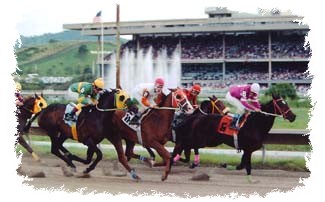
- Old ceiba tree – This silk cotton tree, Ceiba pentandra, is more than 300 years old.
- Old dairy farm
- Town Hall
- Jesús T. Piñero Residence and Museum – home of the first Puerto Rican governor or the island.
- Camarero “El Comandante” Racetrack
- Our Lady of the Pillar Church
- Villarán Park– passive recreation park
- Plaza del Canovanense – the town square honoring the Taino Indians.
- Juan Francisco Arroyo Square
- Spanish bridge – one of the oldest bridges in Puerto Rico
- Ruins of the Canóvanas sugar mill
- Palma Sola panoramic lookout point
Distinguished Citizens:
- Rafael José Albandoz – House Representative (1957).
- Juan Calzada González – first attorney for the municipality.
- Milagros Carrillo– “La Jibarita de Canóvanas” – singer of décimas criollas, and television actress.
- Julio Jiménez – House Representative (1929 – 1936).
- Benjamín Morales – actor
- Francisco F. Mundo – physician
- Gloria María Pagán – poet
- Rey Francisco Quiñones – radio announcer and actor
- Enrique Sánchez Cappa – sports reporter
- Luis Sánchez Cappa – journalist, named journalist of the year in 1976.
- José L. Vázquez Calzada – demographer and college professor; former Secretary of Health.
Public Schools sorted by educational levels.
Fajardo Region
Canóvanas District
| Name | Level | Telephone | Address |
| Elementary | |||
| DOMINGO NIEVES ORTIZ (PALMA SOLA) | K-6 | (787) 886-2994 | HC 01 Box 9074, P.R. 00729-0014 |
| DR. PEDRO ALBIZU CAMPOS | K-6 | (787) 876-4610 | PO Box 1636, P.R. 00729-0000 |
| EUGENIO MARIA DE HOSTOS | PK-6 | (787) 876-2415 | PO Box 10000 Suite 265, P.R. 00729-0000 |
| JUANA RODRÍGUEZ MUNDO | K-6 | (787) 876-4828 | PO Box 1636, P.R. 00729-0000 |
| JULIA DE BURGOS | K-6 | (787) 876-3100 | Box 396 Carr. 876 La Central, P.R. 00729-0000 |
| JULIA DE BURGOS ANEXO | K-2 | (787) 876-3100 | Box 396, Carr. 876 La Central, P.R. 00729-0000 |
| LAS PARCELAS CAMPO RICO | K-6 | (787) 886-3441 | PO Box 1636, P.R. 00729-0000 |
| LUIS MUÑOZ MARÍN | K-6 | (787) 876-6120 | PO Box 229, P.R. 00729-0000 |
| MANUEL AGOSTO LEBRÓN | K-6 | (787) 876-6755 | PO Box 35000 Suite 299, P.R. 00729-0014 |
| PEDRO GUTIÉRREZ | K-6 | (787) 876-6740 | PO Box 1464, P.R. 00729-0000 |
| ESTEBAN PABÓN GARCÍA (LAS 400) | K-6 | (787) 876-7280 | PO Box 1794, P.R. 00777-1794 |
| Intermediate | |||
| ANTONIO R BARCELÓ | 7-9 | (787) 876-4055 | PO Box 999, P.R. 00729-0999 |
| JOSÉ SANTOS QUIÑONES | 7-9 | (787) 876-4493 | PO Box 10000 Suite 477, P.R. 00729-0000 |
| Secondary | |||
| GEORGINA BAQUERO | 7-12 | (787) 876-7807 | Box 35000 Suite 20126, P.R. 00729-0014 |
| JOSÉ CALZADA FERRER | K-9 | (787) 876-4359 | PO Box 10000 Suite 272, P.R. 00729-0000 |
| High School | |||
| EDUARDO GARCÍA CARRILLO | 10-12 | (787) 886-2200 | PO Box 1636, P.R. 00729-0000 |
| LUIS HERNAIZ VERONNE | 10-12 | (787) 876-2395 | PO Box 10000 PMB 478, P.R. 00729-0000 |
Hymn:
Canóvanax – By Doris Sandra Estrada Jiménez
Es mi pueblo natal entre los pueblos,
puente fijo en el tiempo mirando al porvenir.
Defendiendo con furia del paso de los siglos,
la simiente del indio que se negó a morir.
Sus hijos son hilera de luceros que adornan
la frente del guerrero que dio vida a su ser:
Hernaíz, Mister Arroyo, los reyes del canasto
y el monstruo de este siglo que nadie pudo ser.
Roca tallada y barro, piel cobriza y areyto
son el alma de un pueblo que defendió su historia.
Los hijos del futuro recordarán al indio
que vivirá por siempre grabado en su memoria.
Contemplo en la ventana del tiempo, los recuerdos
de un poblado de antaño vino en mi corazón
campanas en la plaza, campos verdes y calles
con ritmo de tambores en inmortal canción.
Y al paso de los años es su historia
recuerdo del maíz yuca y bohique.
Hamacas del pasado meciéndose en el tiempo
y un manojo de estrellas coronando un cacique.

